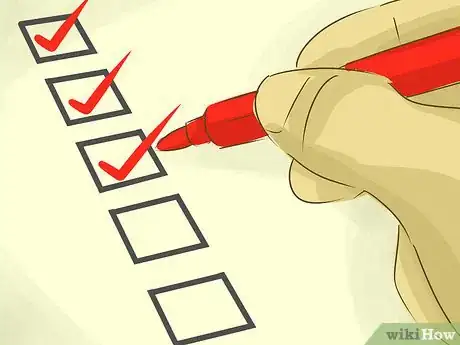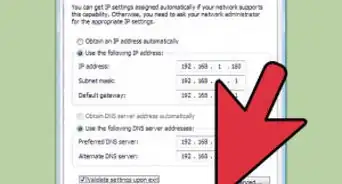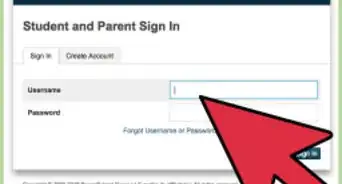This article was co-authored by wikiHow staff writer, Megaera Lorenz, PhD. Megaera Lorenz is an Egyptologist and Writer with over 20 years of experience in public education. In 2017, she graduated with her PhD in Egyptology from The University of Chicago, where she served for several years as a content advisor and program facilitator for the Oriental Institute Museum’s Public Education office. She has also developed and taught Egyptology courses at The University of Chicago and Loyola University Chicago.
This article has been viewed 64,088 times.
Learn more...
Assemblies are an important part of the school experience. They bring students, teachers, staff, and other members of the school community together, and provide opportunities for enriching the students’ education. You might be called upon to conduct an assembly at some point if you are a school administrator, teacher, or student council leader. Organizing and conducting an assembly can be a complicated and stressful task, but with good planning, you can make your next assembly a positive experience for your school.
Steps
Planning Your Assembly
-
1Determine a theme for the assembly. A school assembly can be a great opportunity to create community spirit among students, teachers, and staff. The content of the assembly must be interesting and relevant to the participants, however. Before you begin organizing your event, consider what you want it to be about.[1]
- For example, if you’re having an assembly to celebrate Earth Day, you might focus on how students can reduce their carbon footprint.
- For a first day of school assembly, you could give the students a general introduction to the rules and culture of the school.
- Try to link the content of the assembly to subjects that your students have some prior knowledge of—e.g., a unit they have recently been working on in class. This will make it feel more engaging and relevant to them.[2]
-
2Keep a checklist of things to do before and during the assembly. Organizing an assembly is a complex task, and you’ll have a lot to keep track of. Keep a list of all the things you need to do at each stage of the process, and check them off as you go.[3]
- Have a colleague look over your checklist to make sure you’ve included all the important points.
- Your checklist might include things like contacting potential speakers, arranging refreshment deliveries, and reserving audio-visual equipment.
- You may need to revise and expand your checklist as you get further into the planning process.
Advertisement -
3Enlist 1 or more speakers. You will need at least 1 person to be a presenter at the assembly. Start working on recruiting someone as early as possible, since you will need to schedule a date that is convenient for them and give them plenty of time to prepare.
- Have a conversation with your speaker ahead of time about the theme of the assembly and what role you want them to play in the event.
- Your speaker could be a member of the school staff (e.g., a teacher or administrator), a student, or even a special guest (such as an author, researcher, or local celebrity).
- For example, if you’re holding an assembly to celebrate Black History Month, you might invite a prominent member of the local African American community (such as your local NAACP chapter president) to speak.
- If you can, start reaching out to speakers at least 2 months in advance. This will give them plenty of time to clear their schedule and prepare a presentation.
-
4Plan activities for your assembly if you wish. Your assembly can include more than just speeches. You can create a really memorable and engaging assembly by including other events and activities, such as games, raffles, performances, or question and answer sessions.
- Try to keep assembly activities fun and appropriate for the grade level(s) at your school. For example, a trivia challenge might be a great activity for a middle school or high school assembly. Elementary school students might enjoy physical team-building activities like relay races.
- To find fun ideas for assembly activities, check out online resources like this one from the Washington Activity Coordinators Association: http://www.wacaonline.org/school-spirit.html.
-
5Make a list of people who will attend the assembly. Depending on the nature of your assembly, you may have a smaller or larger number of participants. Knowing who will be present at your assembly is important for logistical planning and safety. Make sure your list includes:[4]
- Teachers and staff who will be attending.
- Speakers and special guests.
- Student groups (e.g., individual grades or the entire student body).
- Parents and other outside attendees.
-
6Schedule your assembly at a convenient time. Carefully check the school schedule to be sure that the assembly won’t conflict with any other important events, such as a field trip or school sporting event.[5]
- In addition to the date, you will need to take the planned length of the assembly into account. For example, if your assembly is set to last 2 hours, try to schedule it at a time when it will not overlap with or cut into other school activities.
-
7Meet with the school staff to create an agenda and management plan. Once you have your theme squared away and have enlisted a speaker, sit down with teachers and other staff members to plan out the details. Keep notes during the meeting, or ask someone else to do so. In addition to coming up with a basic schedule of events, work out a management plan to keep the assembly safe, smooth, and orderly. Take time to discuss issues such as:
- What the themes will be, and how long each part of the assembly will last.
- What types of space and equipment you will need for the assembly.
- What the audience’s role in the assembly will be (e.g., will there be time for discussions or question-and-answer sessions?).
- Whether you anticipate any problems or challenges, such as managing student behavior or providing special accommodations for any guests.
- What roles different participants will play in the event (e.g., will you have staff and teachers on hand to manage seating and monitor student behavior? Can you assign students to hand out programs?).
- The logistics of seating the students. For example, you may wish to seat the youngest grades in front, since this will give them better visibility and keep them more engaged.
- How to handle a potential crisis. For example, how would you evacuate the space most efficiently in case of an emergency?
-
8Send a written agenda to everyone participating in the assembly. Write up a formalized agenda based on your discussion during the meeting. Your agenda should go out to any teachers, administrators, and other staff members who will be involved in the assembly. Be sure to send this out well in advance of the assembly (at least a couple weeks), so that everyone will have adequate time to review it and prepare. Include information such as:
- The date and time of the assembly.
- The theme of the assembly.
- The name(s) of your speaker(s) or special guest(s).
- The schedule of events.
-
9Request any necessary audio-visual equipment. If you anticipate needing equipment such as projectors, microphones, or a sound system, make sure to secure those necessities well in advance. Talk with your school’s administrative office about reserving the equipment you need for the date of the assembly.
- Some schools may require a particular advanced notice period (e.g., at least 2 weeks) for reserving AV equipment. Check with the appropriate office at your school to find out how far in advance to put in your request.
-
10Book your assembly space in advance. In addition to equipment, you will also need an appropriate space for your assembly, such as an auditorium, assembly hall, or gym. Talk to your school’s administration to make sure that the space you need will be available on the date of your assembly.
- Different schools may have different rules for how far in advance you need to book space for an event, but you may need to plan several months ahead. Check with your school’s administrative office for details.
- Make sure the space you select is big enough to safely accommodate your assembly. If not, you may need to divide the event up into multiple parts (e.g., 1 assembly for half of the students in the school, and a second for the other half).
-
11Create assembly programs. Once you have all your details locked down, you can design some formal programs for your assembly. If any students or staff members at your school have an interest in graphic design, they might enjoy being involved in designing the program. Your program should include information such as:
- The name and theme of the assembly (e.g., “Fresh Starts and New Beginnings: Celebrating a New School Year at Wooster Elementary”).
- The date, time, and location of the assembly.
- The schedule of events at the assembly.
- Any other important details, such as information about how attendees can request special accommodations.
Organizing the Assembly Space
-
1Make sure all audio-visual equipment is set up and working. There are few things more frustrating than starting a major event and finding that the AV equipment doesn’t work right. Try to get your equipment set up well in advance (the day before, if you can) and give it a test run to make sure there are no problems before the assembly begins.
- If your school has a technology expert on staff, make sure they are on call in case something unexpectedly goes wrong during the event.
-
2Examine the space to make sure it is clean and in good repair. Do a last-minute check before the assembly to make sure there aren’t any major messes or hazards in the space. Tidy up any refuse or spills, and make sure the seats are all in good condition.
-
3Have programs and other documents on hand. During the assembly, you may wish to provide handouts for participants and guests. Make sure you have enough printouts for everyone who needs them, and that they are on hand and ready to be passed out when the event begins.[6] You may need documents such as:
- Event programs
- Feedback questionnaires
- Logistical information for organizers and participants
- Informational flyers or handouts relating to the theme of the assembly
-
4Get any refreshments set up. If you are providing refreshments, make sure they will be delivered on time and set up so they are available for guests and participants when the event begins. If you’re using a catering service, check in with them in advance (e.g., the day before the assembly).
-
5Check in with all participants to make sure they are ready. Have a brief conversation with anyone who is playing an important role in the assembly, just to make sure you are all on the same page and everyone knows what to expect. Try to do this at least an hour or 2 before the assembly begins, in case you run into any unexpected misunderstandings or problems.
- If you have speaker or special guest, show them the AV setup and review their part in the event. Briefly go over the schedule with them. For example, “First I’m going to give a 5-minute welcome speech, then I will introduce you. You’ll be standing at this podium, and you can load your slide presentation onto the school laptop here.”
- Have a quick debriefing with any teachers, students, or staff members who will be helping with practical matters like seating guests, handing out flyers, or running the AV equipment.
Holding the Assembly
-
1Invite your guests and participants into the space. In order to provide a safe and positive experience for everyone, make sure that the guests enter in a calm and orderly manner. Let your guests know a few minutes in advance that the space is about to open, and call each group in 1 at a time.
- Have each group wait in their classroom before calling them in, so that the halls don’t become overcrowded.
- Hand out programs and other materials as the guests enter the space.
-
2Signal for attention once everyone is seated. This is especially important in a school with younger children, since they may become excited and noisy during an assembly. Let them know that the event can’t begin until everyone is settled and quiet.[7]
- Ask your teachers to prepare their students in advance by letting them know what sort of behavior will be expected during the assembly.
- You can help create a sense of order and community by having the students do a group activity at the beginning of the assembly, such as singing a school song or doing a cheer.
-
3Present a brief welcoming speech. Before the main speaking event, take a few moments to welcome the students and other guests. This is a good time to briefly introduce what the event is about, what the schedule of events will be, and any other important information you wish to provide.[8]
- For example, you might briefly review where the emergency exits are and ask students and other guests to silence their phones.
- Keep it short, upbeat, and to-the-point. Your audience (and your speaker!) will become bored and restless if you give an unnecessarily long and wordy introduction.
-
4Introduce your speaker(s) and allow them to deliver their message. Give a brief biographical sketch of your speaker (it doesn’t have to be more than a few sentences) and a quick summary of what they will be talking about. Make sure to welcome them warmly, and encourage your students and other guests to give them a round of applause.
- For example, you might say, “Dr. Glossop is a psychologist who has been serving our community for the past 20 years. He’s here today to talk to you about some of the challenges you might be facing as you begin your teen years.”
- If there is an interactive element to the presentation, it may be helpful for you to encourage students to participate. For example, if the speaker asks a question and nobody volunteers to answer, try calling on a student.
-
5Announce the start of any other activities or events. If you have activities or events planned for the assembly aside from your main speaker’s presentation, take a few minutes to introduce the event to the audience. Briefly outline any important information about the activity or event.
- For example, if the students will be playing a game, describe the objective and the rules.
-
6Dismiss your guests and students once the assembly is done. After the presentation(s) and any other activities are over, thank everyone who participated (including the audience) and let them know that they are dismissed. Ask the audience to leave the space in an orderly manner, the same way they came in.
- Make sure to thank your speaker(s) and any other presenters or performers when they are finished, before you dismiss the audience. Encourage the audience to give them a round of applause.
-
7Ask your participants for feedback. Feedback can be very helpful in making your next assembly an even better experience. You can solicit feedback by handing out paper questionnaires to your guests or circulating an online survey after the assembly is over.
- You can also have a meeting with school staff after the event to find out what they think went well and what could have gone better.
- You might also encourage teachers to have a conversation with their students after the assembly. After all, the assembly is primarily for the students’ benefit—it is important to listen to their feedback and find out how you might make the experience better and more engaging for them next time.
-
8Take care to clean up the space after the event is done. After the assembly is over, turn off any equipment and make sure it is properly put away or returned to its original location. Clean up any messes, such as scattered papers, empty containers, or spilled refreshments.
Community Q&A
-
QuestionWhat all is needed for an assembly?
 Community AnswerYou need to choose a time and date. If it will be during school hours, you would want to do it during classes that aren't as important. You will also need to talk to staff members about it, and mainly the principal.
Community AnswerYou need to choose a time and date. If it will be during school hours, you would want to do it during classes that aren't as important. You will also need to talk to staff members about it, and mainly the principal. -
QuestionHow do I plan an assembly based on a theme New Beginnings?
 Community AnswerWelcome to New Beginnings. This year we will have the following new programs for you: List them here. Make it exciting. Before the assembly tape numbers under their chairs or bleachers. Tell them to reach under their seats. Call out the numbers and be sure you have cool stuff to provide the the new beginnings. You should be able to get a lot of cool stuff from local merchants for free.
Community AnswerWelcome to New Beginnings. This year we will have the following new programs for you: List them here. Make it exciting. Before the assembly tape numbers under their chairs or bleachers. Tell them to reach under their seats. Call out the numbers and be sure you have cool stuff to provide the the new beginnings. You should be able to get a lot of cool stuff from local merchants for free. -
QuestionHow do I conduct a school assembly on the first day?
 Kim GTop AnswererYour first day of school assembly can have a theme of "Welcome Back" or "New Beginnings" to help the students transition to the new school year. You can include a question-and-answer session for the students, or have other types of interactive activities. Since this is the first day from back to vacation, you may want to keep the assembly fairly short.
Kim GTop AnswererYour first day of school assembly can have a theme of "Welcome Back" or "New Beginnings" to help the students transition to the new school year. You can include a question-and-answer session for the students, or have other types of interactive activities. Since this is the first day from back to vacation, you may want to keep the assembly fairly short.
References
- ↑ http://kidzrio.com/how-to-present-a-weekly-assembly-notice-themes/
- ↑ http://kidzrio.com/how-to-present-a-weekly-assembly-notice-themes/
- ↑ https://daveruch.com/school-assemblies-13-things-every-planner-should-know/
- ↑ https://daveruch.com/school-assemblies-13-things-every-planner-should-know/
- ↑ http://www.teach-nology.com/teachers/assemblies/
- ↑ http://www.teach-nology.com/teachers/assemblies/
- ↑ https://www.educationworld.com/a_curr/shore/shore025.shtml
- ↑ http://www.teach-nology.com/teachers/assemblies/
- ↑ http://www.teach-nology.com/teachers/assemblies/



















-Step-10.webp)































































